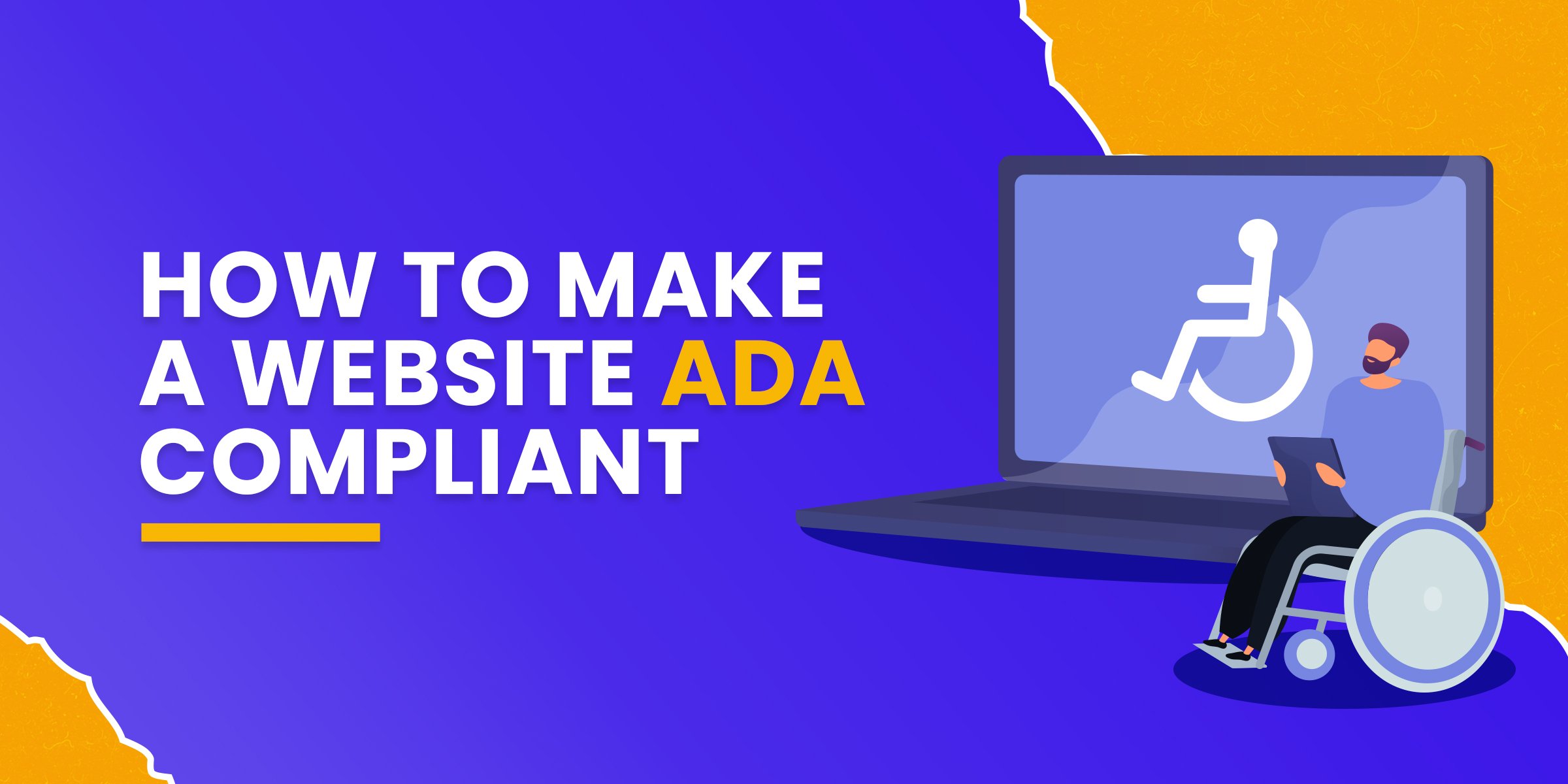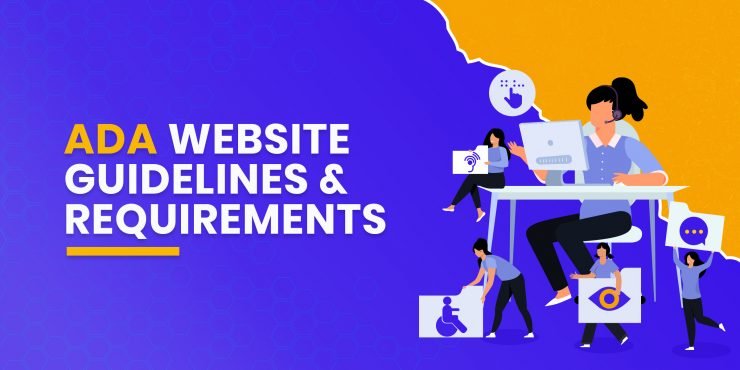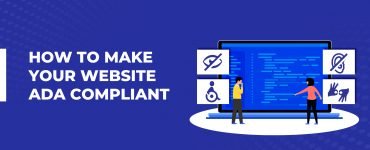For most of us, it's hard to imagine trying to navigate the world today without the internet. We use it for almost everything: shopping, research, consuming media, making reservations at restaurants… the list goes on.
Our Top Recommendation for ADA Compliance
- Make your website ADA compliant in minutes
- Stay protected with real-time accessibility monitoring
- Save thousands of dollars in development
However, the internet isn't accessible to all. Individuals who have a disability may have major difficulties using the internet, or may not be able to at all. This is because not all websites are set up with ADA standards in mind. Luckily, web developers today often ensure meeting ADA standards is the first thing they focus on.
Below, we'll take a look at everything you need to know about ADA website compliance. We'll discuss everything from what it means to be ADA compliant, why it's important, and provide complete ADA-compliant website guidelines.
We offer this website completely free to our visitors. To help pay the bills, we’ll often (but not always) set up affiliate relationships with the top providers after selecting our favorites. However, we do our best not to let this impact our choices. There are plenty of high-paying companies we’ve turned down because we didn’t like their product.
An added benefit of our relationships is that we always try to negotiate exclusive discounts for our visitors.
What is an ADA-Compliant Website?


In 1990, the Americans with Disabilities Act was passed. This act prohibits discrimination in public life based on disabilities. In this case, public life means schools, employment, public transportation, or any other public place. As a result, employers need to accommodate employees with disabilities, and all public locations need to be made accessible.
This is also where the idea of an ADA-compliant website came from. In 2010, the Americans with Disabilities Act Standards for Accessible Design was passed by the U.S. Department of Justice. This requires all information and electronic technology, such as websites, to be accessible to people with disabilities.
Before 2010, Google began to incentivize websites to consider ADA website requirements by giving websites that were compliant higher spots in their search results. While this is certainly a step in the right direction, there is still a lot of progress to be made in terms of website ADA compliance.
To be an ADA compliant website, you simply need to ensure that individuals with all disabilities can use your website in a way that works for them.
Why is ADA Website Compliance Important?


It goes without saying, but all individuals should be able to access the internet regardless of ability. People who are disabled deserve the same accessibility as everyone else, and it's simply human decency to provide this accessibility. With an estimated 15% of the world population being disabled, not utilizing ADA website requirements leaves about 1 billion people without the resources the internet provides.
If a website doesn't follow the ADA website compliance checklist to make it accessible, it will result in a bad user experience. This isn't all, however; following these ADA guidelines can also provide benefits for users who are not disabled. By doing so, your website will be of much higher quality. In addition to quality, you can expect the following benefits for non-disabled users:
- Positive Image: By showing you care about ADA website accessibility, you can stand out from competitors in your field as a company that cares about its users. This can result in a boost in reputation and an increase in potential customers. It's important to people that the businesses they interact with care about their customer base and seek to be inclusive to all.
- Improves SEO: We discussed previously that Google gives higher priority to websites that are accessible. This does wonders for SEO, or search engine optimization, by giving your site better exposure. Adding accessibility features will also increase the chances that search bots will index your website. Since SEO standards and ADA standards tend to overlap, it's an easy way to get such a benefit.
- Normalizes Accessibility: The more sites that prioritize ADA website accessibility, the more normalized this practice will become and the easier it will be to convince websites to become accessible.
- Increase Your Audience: It goes without saying that making your website accessible to more people will allow more people to visit your website. Not only is it a decent thing to do, but it's also good business practice. This is especially true since not many sites follow the ADA compliance website checklist; you'll be able to get the customers that those sites can't.
- Increased and Improved Usability: Both users with and without a disability will benefit from a website with higher usability. These websites are easier to navigate and provide a great user experience.
- Avoids Legal Issues: Avoiding complying with the Americans with Disabilities Act guidelines could potentially leave you vulnerable to legal issues. While this area is still largely unregulated, nothing is preventing an individual with a disability from filing a discrimination claim if they cannot access your site. This can all be avoided if you choose to comply automatically.
- Establish a Better Website: Anyone will tell you that, as a general rule, universally accessible sites are better than ones that aren't. Many ADA guidelines are included in web design and development best practices.
Does My Website Need to be ADA Compliant?


According to Title I of the Americans with Disabilities Act, any business that has at least 15 full-time employees and operates for 20 or more weeks per year needs to comply. The same applies to businesses that are considered public accommodation, like banks, hotels, retail spaces, and public transportation. If your business has a website and not a brick-and-mortar location, that website is considered the “primary location” of that business.
For both of these examples, both the digital and physical considerations of accessibility apply. While there aren't any federal codes referring to ADA-compliant website guidelines, it is still true that they need to accommodate users with disabilities. The U.S. Department of Justice has set a deadline for all federally funded agencies, schools, and businesses to bring their websites up to the standards of ADA compliance. For this deadline, the WCAG 2.0 standards are used. These are used by both The Rehabilitation Act and the ADA.
Legal Implications of Not Being in Compliance


If your business ignores the ADA compliance website checklist and is in violation of this, meaning your website is inaccessible, you could face some serious consequences.
Lawsuits by disabled individuals are growing more and more common if or businesses or other institutions are lagging behind their peers when it comes to compliance. One such ADA website compliance lawsuit in 2014 refers to a blind parent suing a school district, claiming that the official school websites were incompatible with a screen reader.
Many disabled individuals use screen readers when using the internet. They read online content out loud and can also connect with an additional device to display braille. This is a massively helpful tool for many people, so it's always an issue if websites refuse to accommodate this technology. In the case of the 2014 compliant, the school board was expected to spend anywhere from $665,000 to $815,000 between staff training, an accessibility coordinator, attorney fees, and to implement the needed changes.
As you can see, there can be a significant amount of money lost between attorney fees, implementation, lawsuits, and fines. A lot of specifics go into determining the ultimate cost of violating these rules and can vary depending on the entity that is in violation.
In general, the government fine for an inaccessible website can range from $55,000 to $75,000. If the situation isn't fixed and these violations continue, you can expect to be charged additional fines of about $150,000.
How to Make a Website ADA Compliant


So, you may be asking yourself, is my website accessible? If you have come to realize that it's not, we have a comprehensive checklist for you to follow to make your website ADA compliant.
Checklist for Individuals with Visual Disabilities
First, let's take a look at some necessary measures to take when you're making your site usable for folks with visual disabilities.
Accessible for Screen-Readers
As we mentioned above, screen readers are a great resource for people with visual disabilities. When creating your website, make sure that the contents can be easily processed with a screen-reader. At the same time, this allows text-to-speech programs to be able to read text easily. Make sure that all headers, links, and lists are identified with descriptive terms that avoid slang. The text needs to be concise and simple to read. The goal is to communicate this information as clearly and simply as possible.
Zoom Functions
Make sure that zoom functions are usable for both your desktop and mobile sites. Test the layout to make sure that it is still able to adapt and function at up to a 200% zoom for the desktop.
Text, Not Images
Any important information should be relayed through text, not through an image or even text within an image. If you have an image that is critical for your site and needs to be included, make sure to include a description or alt text.
Contrast and Color Coding
Color can be a great way to share information or meaning on your website, but make sure that it isn't the main element you use. If the contrast between text and backgrounds is inadequate, it could be unreadable for some. Offering a few options for color schemes for users to choose allows them to pick which works best for their ability.
High-Level Descriptions
Each page should have its unique header and title, and each hyperlink needs to have unique anchor text. In addition, they should be able to convey to the user exactly what the page they are visiting is about. Details like leaving the hyperlinks underlined are also recommended. A lot of these are also considered to be SEO best practices, so you really can't go wrong with this one.
Flexible Text Size
Allow your font size to be adjustable, so individuals can choose how large they need the font to be. This makes all pages much easier to read.
Alt Text for Photos
All videos and pictures need a description to accompany them. This descriptive text will make it easy for search engine bots and screen-readers to understand any photo or video you have.
Checklist for Individuals That are Deaf or Hard of Hearing
Now let's take a look at some recommendations for hard of hearing or deaf compliance.
Multiple Contact Options
Have options when it comes to methods of contact. Include a phone number and an email address. A webform and physical address are also good ideas. This gives viewers options, so they can choose which method is best for their situation.
Use Simple English
Avoid jargon, slang, complex sentences, and uncommon words as much as possible. Think of English as a second language for people who are hard of hearing, with sign language being their first.
Audio Transcripts
If you must use videos or audio clips, provide a text-based transcript. Make sure these can be used by screen readers.
Subtitles and Closed Captioning on Videos
Regardless of the language used, always include subtitles on any videos you have. Also, vet your captions to make sure they are correct and easy to understand.
Closing Thoughts
It may seem like a lot of information to digest at first, but it all comes down to making it easier for all people to access your content. In the end, in addition to becoming ADA compliant, your website will be better for these improvements for all users, not just those with disabilities. Just refer to this guide and your website will be ADA compliant in no time!
Our Top Recommendation for ADA Compliance
- Make your website ADA compliant in minutes
- Stay protected with real-time accessibility monitoring
- Save thousands of dollars in development






















